
Retail marketing helps your business expand its reach, connect with customers, nurture relationships and tell your brand story. It can also be used to differentiate yourself from your competition.
Problem is, setting the right budget ratios for retail advertising can be tricky. Should you think outside the box and blow your budget on a series of in-store events? Will social media be more effective if you spend money on video creation or ads? Which social media should you focus on? Gone are the days of choosing between TV, radio and print ads—retailers have more advertising channels than ever, and there is no one-size-fits-all strategy.
In this article, we’ll go through 16 advertising and retail marketing ideas and retail marketing tips that will help your brand stand out.
- What is retail marketing?
- Retail advertising ideas to catch the eyes of potential customers
- Marketing and promotion ideas for retail stores
- How to implement your retail marketing strategy
Prepare your business for the future of commerce
Download our free playbook and learn how to sell on different channels, boost loyalty and increase foot traffic with technology.
What is retail marketing?
Today, retail marketing, also known as retail advertising, can mean organic content (like blog posts), paid content (like advertisements) or a mix of both. This includes both in-person and digital strategies, which can encompass everything from running giveaways on social media to having a sign outside your brick-and-mortar store detailing a special promotion.
In many cases, businesses benefit from using a combination of retail marketing strategies at once (which is sometimes referred to as a “marketing mix”) to reach more people.
However, knowing exactly which portions of your budget to allocate to each part of the mix isn’t cut and dry. Some companies will get by with an entirely social media-based strategy, while others thrive with direct mail and referral campaigns. The trick is to know what retail marketing strategies work for your customer base, which means testing and recording results to fine-tune your approach.
The 4 Ps
Retail marketing has four key components, also known as the “4 Ps”: Product, Price, Place and Promotion.
- Product. First is the product, which is the physical item that’s being sold.
- Price. The second is price, which refers to the pricing strategy that the merchant uses to sell the item. (Examples include “everyday low prices,” implementing pricing psychology like using $X.99, etc.).
- Place. Third is place which refers to the location or platform used to sell products.
- Promotion. Finally, there’s promotion, which is what the retailer does to get the word out and entice sales.
Successfully executing your retail marketing strategies requires a solid handle on the 4 Ps. Tracking these components and ensuring that they’re all working together is essential to any marketing initiative.
Want one of our best retail marketing tips? Use a POS and retail management system that allows you to manage the 4 Ps with ease. With the right platform, you can semi-automate your products, prices, places and promotions, so you can focus on bringing your retail marketing ideas to life.
When you’re considering which advertising strategy to use for your business, it’s a good idea to look at a number of different options to see what would work best.
8 retail advertising ideas to catch the eyes of potential customers
Here are some ideas that can help you bring new customers into your store (or to your ecommerce site).
1. Leverage social media
When it comes to retail and social media, there are four platforms you should seriously consider:
- TikTok
These are the most consumer-centric networks, making them ideal for merchants looking to reach new customers.
Marketing on Facebook
Even with the rise of newer platforms like TikTok, Facebook is still the most popular social media platform in the world, with more than three billion monthly active users.
Facebook is ideal for sharing frequent updates with customers, promoting products, creating on-platform events and features like live broadcasting to make meaningful connections.
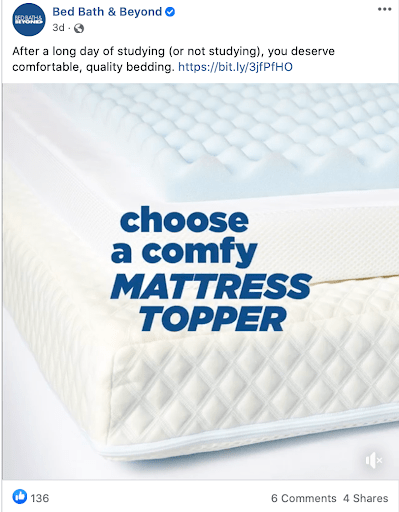
You can also provide direct links to your website in your posts, or connect your Facebook page to a shoppable catalog.
Start a Facebook Group
Think of Facebook Groups as clubs or communities where your most engaged customers and fans can congregate.
One example of a company that’s leveraging Facebook Groups is Peloton, an indoor cycling brand. The company established the Official Peloton Rider Page, which is “intended to be a community board for Peloton members to share their experiences on the Peloton bike and iOS app.”
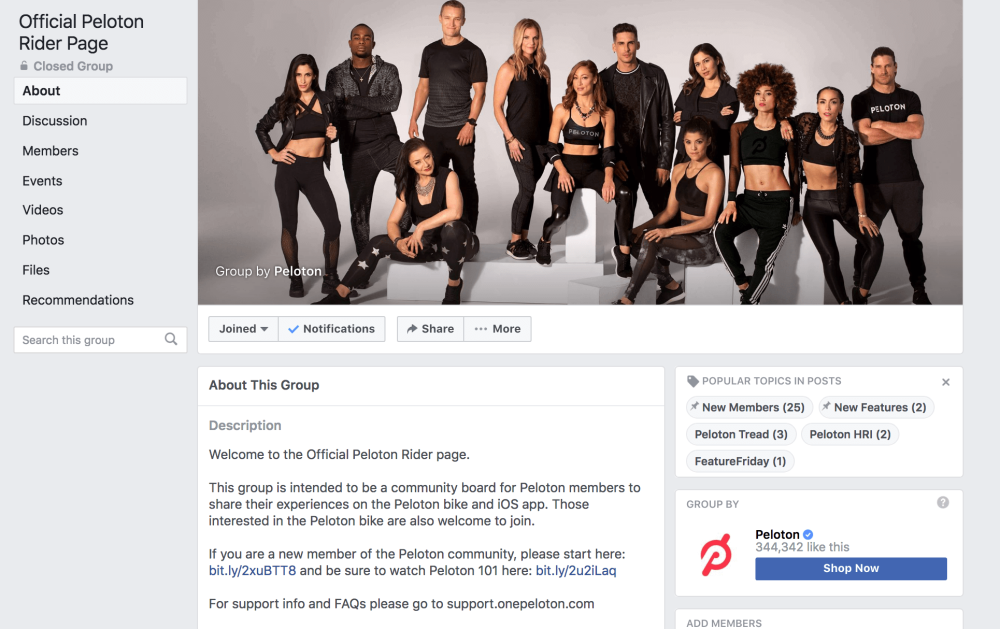
The group is very active, and people use it to share their workouts, ask questions, dish out tips and more.
See if you can do something similar for your Facebook presence. If you sell something that’s centered around a particular lifestyle or interests (e.g. fitness, food, crafts), then consider creating a Facebook Group for your customers and potential customers.
Run Facebook ads
If you’re running Facebook ads, your team should be taking advantage of Facebook’s A/B testing features and keeping track of metrics (e.g. clicks, engagement, sales, etc) to optimize future campaigns.
Take note of the numbers, then use those insights to determine your return on investment (ROI). This will help you determine which ad types are right for you and how much to budget for Facebook advertising.
If you’re looking for an effortless way to run ad campaigns that convert, Lightspeed Advanced Marketing lets you create automatic customer segments by behavioral data, attribute sales and revenue to your marketing campaigns so you know which ones are working, create highly targeted Facebook ads that supercharge results and way more.
Marketing on Instagram
Instagram is one of the most popular social platforms today, with over a billion monthly active users. What started as a photo sharing app in the early 2010s has now become a full-blown photo, video and shopping destination for consumers and businesses alike.
Your business can connect with your community by sharing short video clips to Instagram Stories or Reels, posting product or in-store photos to the feed or hosting live events through Instagram Live. You can also share longer videos through Instagram TV (IGTV). And creating an Instagram Shop will let customers view and buy products directly from the app.
Carefully curate your visual content
Want another essential retail marketing tip? Your Instagram posts should be anything but random. Your business needs to create a clear brand aesthetic so that when people visit your profile, they get a quick idea of who your brand is.
Check out Clad and Cloth’s profile. You can see instantly from their collection of photos that this brand produces casual clothing items and likes a clean, neutral palette with pops of color.

So, if you haven’t done so yet, spend some time thinking about your brand aesthetic—does it need a refresh? Ask yourself what kind of first impression you want people to have about your brand. The answer will give your social media manager direction for your Instagram’s look and feel.
Use Instagram Stories
Instagram Stories allow you to be more informal with your aesthetic, as people expect Stories to be more spontaneous and less curated. You can use them to give people behind-the-scenes glimpses at your store or showcase new products.
A secondary feature of Instagram Stories is that you can create a few permanent ones to display on your profile, highlighting things you really want your potential customers to see.
Check out what Rose & Funk is doing. The retailer uses these permanent Story spots to make it easy for people to view interior designs, shop for items and more. They even created custom Story cover images to make them look more attractive.
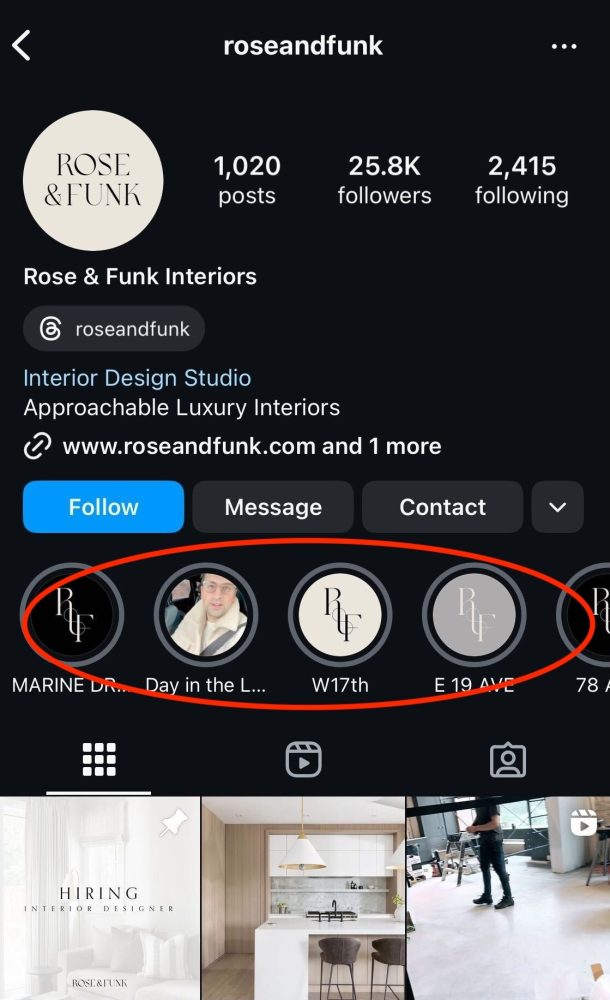
Stories can also do double duty as Reels, always-on videos with a wider reach beyond just your followers. Instruct your marketing team to set a threshold of engagement—if a story passes it, it’s a candidate for being converted into a Reel.
Marketing on Pinterest
If you have an ecommerce website, using Pinterest is a smart choice. Pinterest, like Google and YouTube, functions as a search engine. Over 500 million users flock to the platform to research buying decisions or find inspiration and how-to guides. If your business can provide the answer they’re looking for, you’ll likely find success.
You can also work on creating content-focused pins with tutorials showing how to use a product. Here’s a great example from Sephora’s page:
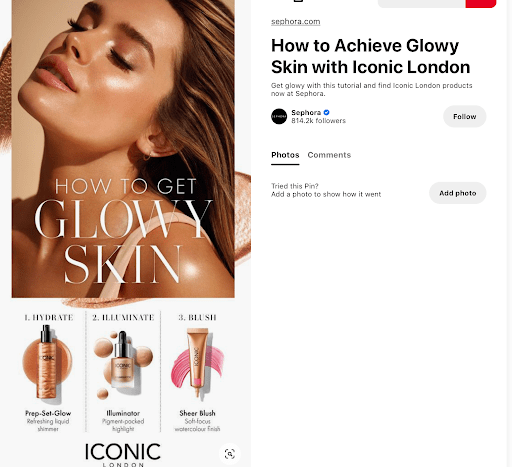
Pinterest also has shopping capabilities, so you can tag your products in certain pins for customers to shop directly from the platform. Advertising on Pinterest is another popular option. Promoted Pins can help you create targeted campaigns so that your ideal demographic will see your content.
Curation is key
Like your Instagram profile, make sure that your team keeps your Pinterest boards carefully curated. Boards should be curated to make it simple for potential customers to navigate to things they’re interested in.
J.Crew, as you can see, has boards that make it easy for you to discover their denim collection, vintage styles and even shop by stripes.
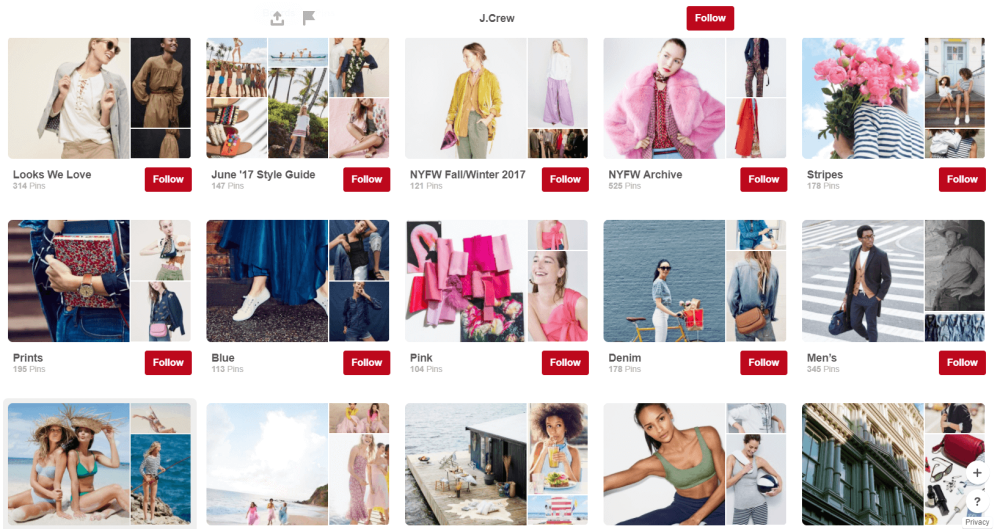
Be patient
The Pinterest algorithm doesn’t necessarily surface your content quickly. It can often take up to six months for your content to really start appearing in people’s feeds. So while your business should be pinning your products, pages that will do best for you organically are likely to be links to your blog posts.
You can allocate a budget for blog posts specifically for Pinterest, such as gifting guides that help get your brand lift and will then direct your customers to your correct pages all year round. As for products, they’ll do great on Pinterest in ad form.
Marketing on TikTok
TikTok is taking the social media world by storm. As one of the world’s fastest growing apps, TikTok became the first non-Facebook owned app to reach 3 billion installs globally.
The short-form video format combined with TikTok’s interest-based algorithm makes the platform very small-business friendly. If you have someone on your team who is comfortable in front of the camera, all you need is a smartphone and our tips and tricks to get your business seen by thousands.
By connecting your ecommerce platform to TikTok through the TikTok Pixel, you can gather data about sales and customer actions on your site. You can use that data to create more effective ad campaigns and attract your target audience to your store.
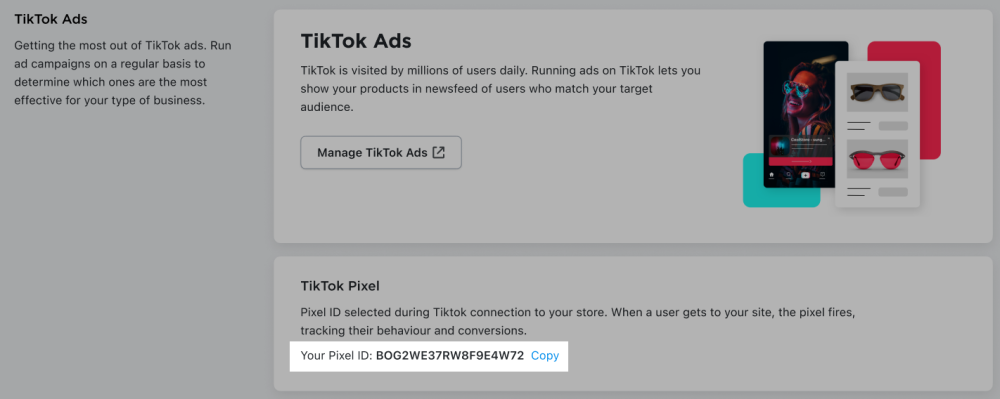
2. Beef up your email marketing
Email marketing is still the most effective marketing channel, bringing in major ROI for businesses worldwide. Taking advantage of email to acquire new customers just requires a little savvy—and a centralized tech stack that lets you sync customers across all of your locations and channels certainly can’t hurt.
This is something Sunmed, Your CBD Store, America’s largest brick and mortar CBD chain, knows all too well. Before switching to Lightspeed’s one-stop platform to power their entire business, efficiently managing customer profiles and segments—and being able to send consistent messaging—was a serious struggle.
“We were seeing a lot of duplicate customer records in our stores. So at the same store, you would have the same customer with three or four different profiles… Lightspeed has enabled us to capture more accurate customer master file data, which enables us to better understand customer needs.” — Wilfredo Rodriguez, CFO, Sunmed, Your CBD Store
One of the best things about email marketing is that it allows you to keep customers engaged without depending on (or bending over backwards to please) an algorithm.
Here’s another one of our favorite retail marketing tips: use email marketing or loyalty software to send segmented campaigns based on your customers’ past purchases and current behaviors, such as abandoned carts or views of a specific product page. This form of targeted marketing is really powerful, and a great way to remind customers that you’re around.
Segment your non-customers
The best way to use email marketing for getting new customers is to segment your subscribers who haven’t purchased yet into their own list. (For even more effective and personalized emails, you should further segment this list by other relevant pieces of information.)
You can then send people who haven’t purchased yet targeted campaigns with first-time buy offers or giveaways.
Showcase your story and values
Another great campaign idea is to send an email detailing your brand story. It’ll get people engaged with your brand and excited about your values.
The Farmer’s Dog is killing it on this front. Check out this gorgeous email sent to customers who haven’t yet purchased a product. Their story is touching and the 20% off coupon is a solid CTA to end on.
(And fun fact: their marketing automation software also serves a personalized 20% off CTA to customers who read the email and then go to the website independently. Genius.)
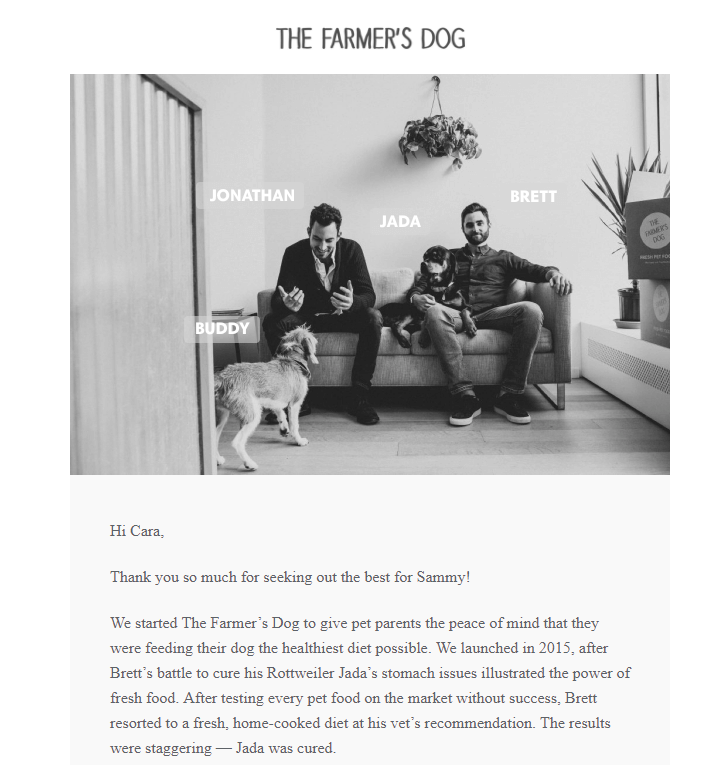
Provide value
Email promotions aren’t the only way to acquire new customers.
You also have to think about the long game of email + content marketing, in which you send valuable content without any hard sells or strings attached. This builds trust and positions your brand as an authority, so when people are ready to buy, they’ll think of you.
Check out what The Dollar Shave Club (DSC) is doing. While DSC sends promotional emails now and then, they also have “DSC Original Content” emails that contain informative (and entertaining) articles on grooming, health, style, work and more.
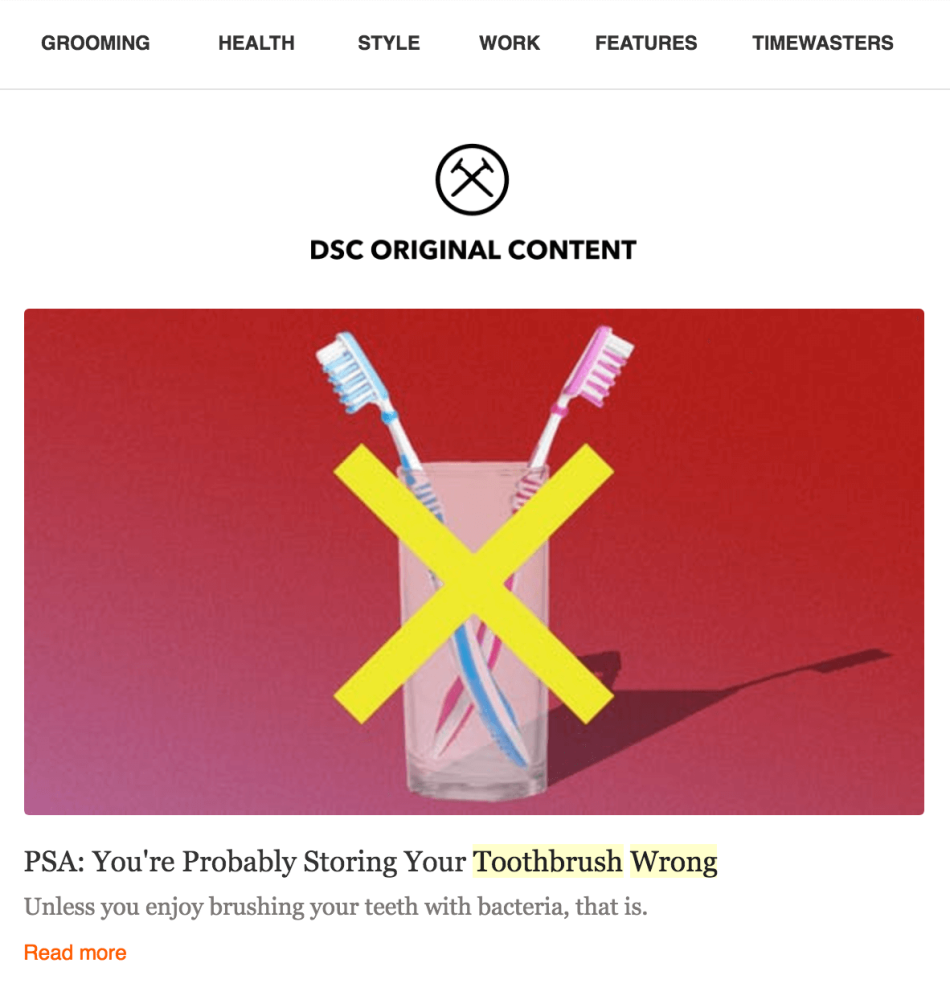
3. Consider influencer marketing
Influencer marketing, if done well, can help your business reach its marketing goals. But one of the lesser-known retail marketing tips is that when it comes to influencers, follower count isn’t everything. In fact, engagement rate is a better metric for determining whether or not an influencer is worth partnering with.
Influencers in the middle often have much higher engagement rates than their mega or micro follower counterparts—think 5,000 to 500,000 as a budget sweet spot. A high engagement rate signifies a high amount of trust, and therefore a higher likelihood of conversion for your business.
Find influencers that create content for the same target audience as your business and see if they are interested in partnering with your brand. You can do this by searching through your tagged photos, relevant hashtags or even your competitors’ accounts to create a shortlist of people to reach out to.
You can hire influencers to create photos or videos promoting the products in your store or a specific event, like a grand opening.
How Morphe skyrocketed sales with influencer marketing
One brand, Morphe, used influencer marketing to become one of the most powerful names in the beauty industry in less than a decade. Morphe was founded in 2008 with the intention of using beauty influencers, particularly those on Youtube, as their primary way to generate sales.
They have given many, many beauty influencers affiliate codes, but Morphe really refined the art of marketing by working very strategically with a certain few top influencers, whom they pay extra.
They also collaborated with these influencers to create customized beauty items, like eyeshadow palettes, which the influencers then encouraged their followers to purchase.
This strategy paid off in a big way when Morphe’s top influencer, Jaclyn Hill, delivered Morphe 1 million sales of her palette in just six months. At $38/palette, that’s pretty life-changing for a brand.
4. Use your in-store assets
In-store retail marketing focuses exclusively on leveraging the customer’s in-store experience to promote brand and product awareness. Some of these strategies will also drive traffic into the store.
There are seven in-store retail marketing strategies you should think about using if you have a brick-and-mortar retail store:
- in-store merchandising
- window displays
- curbside displays
- staff training
- partnerships and collaborations
- in-store or virtual events
- referral and loyalty programs
In-store merchandising
The best way to attract and convert customers is to wow them with your amazing merch. See to it that you’re always stocking the right products. Then once you have the right merchandise, come up with creative displays and arrangements to make them pop.
In-store visual merchandising includes everything from storefront displays and product displays to your cash wrap and retail POS system. The idea is to display your products in a way that draws attention to them and inspires customers to make a purchase.
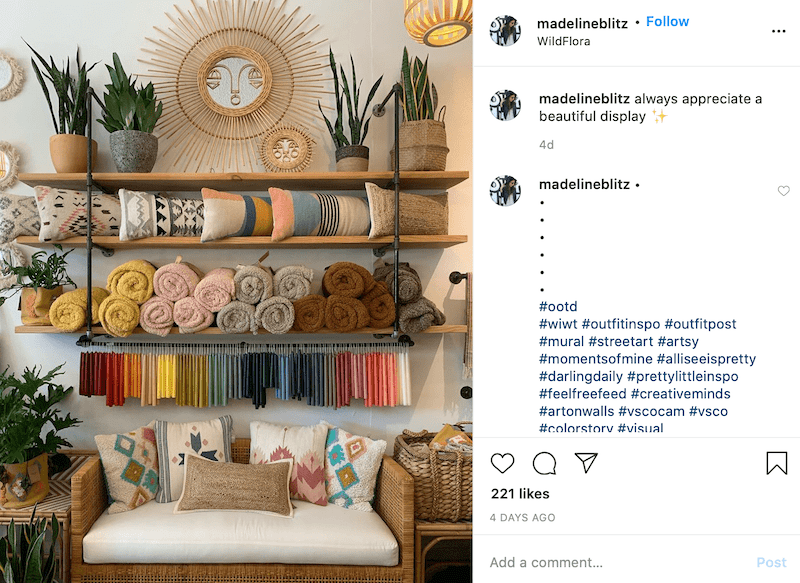
This can include any of the following:
- Signs promoting your special deals, like a buy-one-get-one offer
- Putting your fastest-selling items on a mannequin in the center of the store
- Point of purchase displays near your register encourage users to make last-minute impulse purchases
- Identifying your “lakefront property”—the area of your store that generates the most revenue
Window displays
Window displays are a great way to capture people’s attention as they’re walking or driving by your retail store, hopefully drawing them in. You can show off some of your best-selling merchandise and represent your brand in an exciting, creative way.

When creating window displays, use lighting, color and mood to your advantage.
Keep changing things up and try to update your displays at least once a month. For busy shopping seasons like the holidays, you want to do it every couple of weeks or even every week if possible.
Every retail store is different, so certain design tips may work better than others. The “best” design or look depends on your customers, so zero in on who you’re targeting and create a playbook for managers to craft displays specifically for them.
Also, consider telling stories with your displays. You can do this by selecting a theme, and finding stories in line with it.
Check out what Anthropologie is doing. The apparel retailer changes the window displays of its stores depending on certain seasons or events. But, what makes their window displays exceptional is that Anthropologie always finds a unique angle or story within its chosen theme.
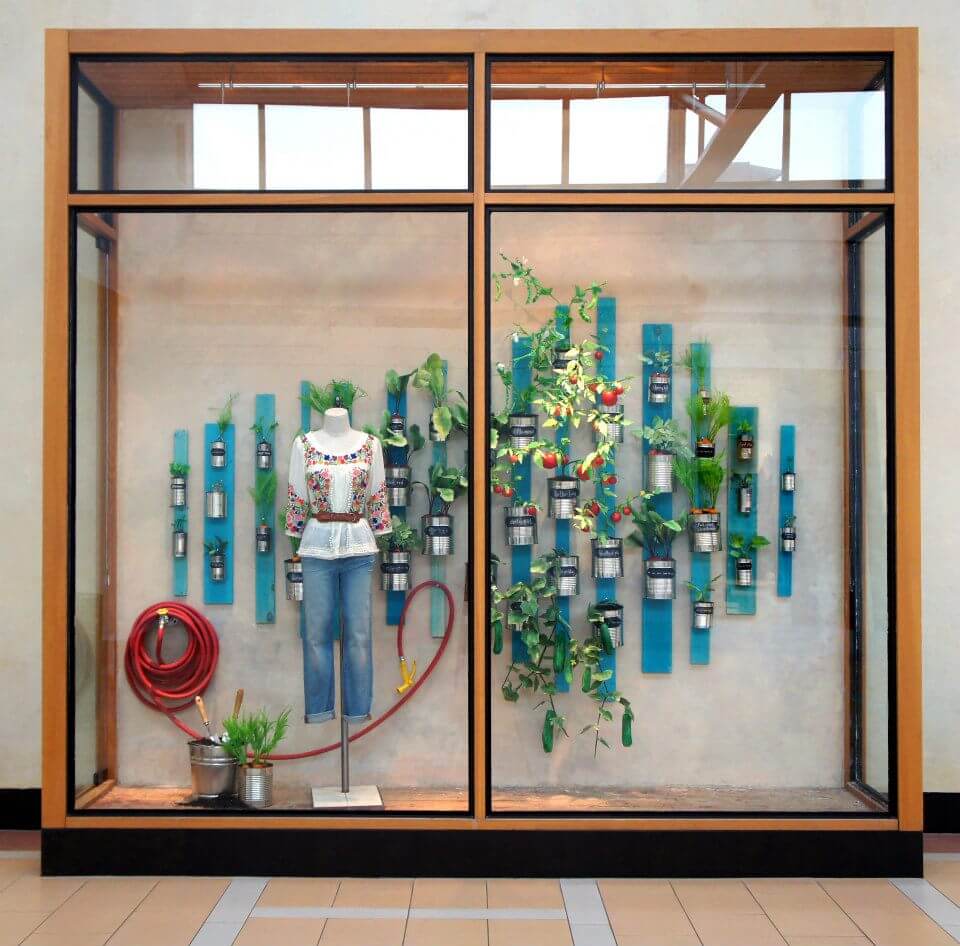
For instance, for Earth Day 2013, the retailer decided to “pay homage to the gifts of gardening with a variety of handcrafted fruits and veggies, and containers made from recycled cans, tires, bottles and more.”
Curbside displays
Curbside displays are similar to window displays in that they also aim to capture attention and foot traffic as people walk past your store. For example, something as simple as a sandwich board outside your shop with some eye-grabbing text or art.
This is a great place to mention any specials or ongoing promotions that you have. These are typically relatively low cost to create, especially if you’ve got standard evergreen options or are using a chalkboard display that can be changed up easily.
Check out this great example from Covet Shoppe & Jewelry Bar in San Francisco.
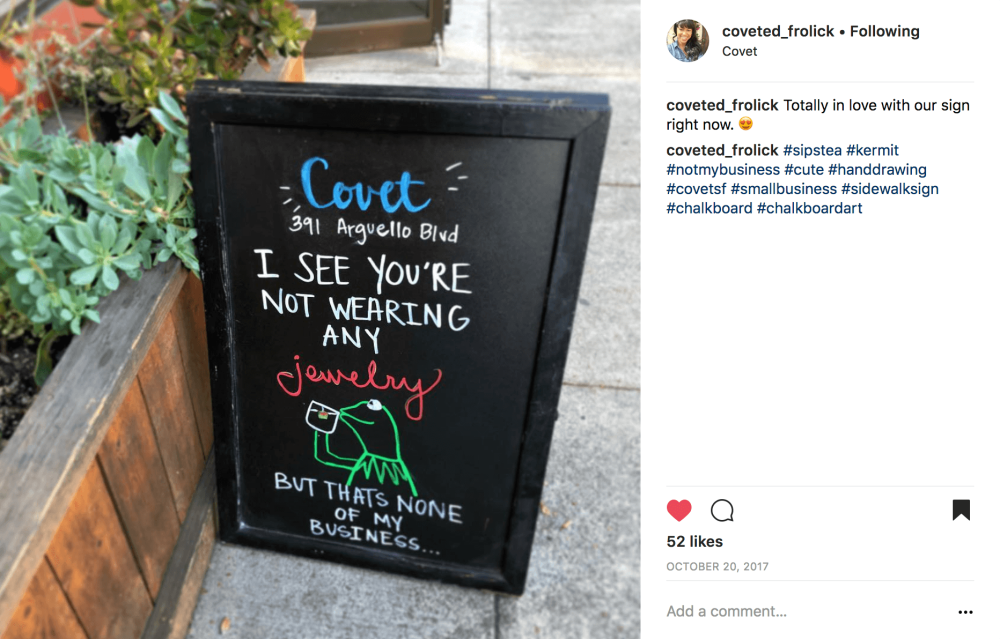
Staff
Your staff should all be trained in advanced sales techniques and know your inventory well. If they do, they’ll be able to do the selling for you, guiding customers to products that they’re looking for and even pointing out a few that they weren’t.
Well-trained staff, especially if they have access to advanced retail software that clearly displays information about customers, will be able to identify potential add-on purchases, leveraging cross-selling and upselling to boost the overall purchase value. They’ll be excited about your brand and your products, so your customers will be, too.
Partnerships and collaborations
Establishing partnerships with other businesses is an excellent way to expand your reach and connect with a new audience.
One popular way to land a partnership is to pitch your products to be sold at complementary businesses. For example, if you own a pet store and manufacture your own line of dog shampoo, you might be able to partner with a local veterinary office to see if they would stock your products.
Here are a few more ideas:
- Partner with the stores who are geographically close to you. For example, if your store is in a strip mall or downtown area, you can ask the stores around you to offer your coupons to their customers (in return for you doing the same). The upside here is that you’ll be directly reaching shoppers who are conveniently positioned to just pop by.
- Partner with businesses who are a little further away from you but serve the same type of clientele. For example, if there’s a great local cafe in your city and you sell handmade loose-leaf tea infusers or artisanal mugs, you may want to approach that cafe to see if they would be interested in stocking some of your products or offer your coupons to their customers. You may even be able to set up a pop-up shop in their location for a day.
- Partner with a local charity to put on an event. Customers today are much more socially conscious and like to shop with brands who care. Partnering with a local charity gives you the chance to hit two birds with one stone—getting your brand name out to a new set of people and showing your customers you care about making a difference. Choose a charity whose values align with your own and set up an event.
5. Consider SMS marketing
SMS marketing has been making waves, and for good reason: people love their phones. Research shows that US consumers check their phones 52 times a day and that text messages have a higher open rate (98%) compared to email (25%).
That’s why if you haven’t dipped your toes into SMS retail marketing, it may be time to do so. Start collecting your customers’ mobile numbers and send—with their permission—relevant marketing communications. Your marketing team can save time and make these communications more targeted by integrating your SMS platform with your POS to automate SMS campaigns.
One retailer that’s seen amazing results with SMS marketing is Federation +, a popular streetwear brand in New Zealand.
Federation + markets its brand on multiple channels, including SMS. One notable initiative is the brand’s end of the year SMS campaign, in which customers were offered a 20% discount both in-store and online. To give people a sense of urgency, the offer ended at midnight the same day.
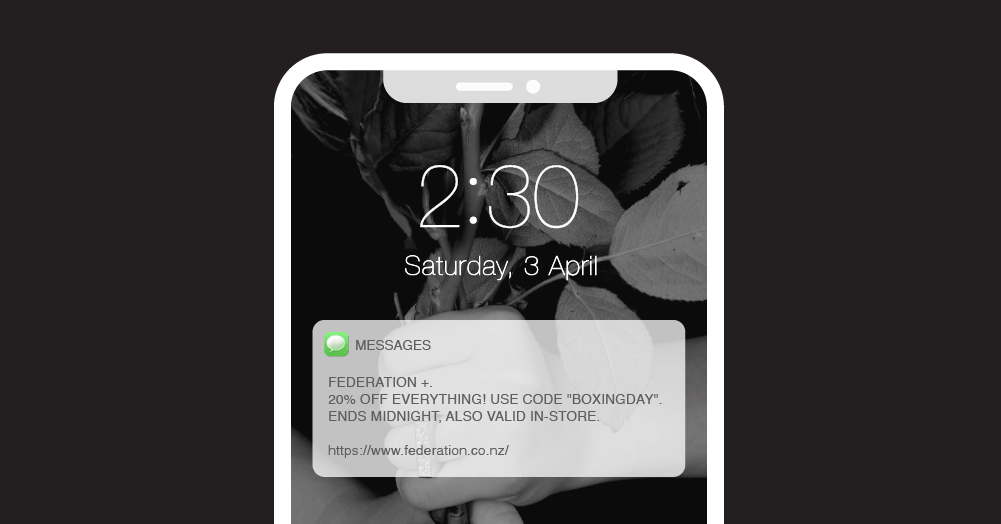
The initiative worked incredibly well. The campaign had a 95% delivery rate, an 8% click rate and a conversion rate of 11%. Suffice to say, Federation + ended the year strong!
6. Leverage video
In many cases, the best way to market your merchandise is to show your products in action. This is easily doable in-store, where shoppers can touch and feel products or even try them on. However, when marketing online, you need to get more creative with your visuals.
Enter video marketing. When leveraged correctly, video does an excellent job of showcasing the use cases and value proposition of your merchandise.
Here are some quick tips for directing your team to use video in your marketing:
- Make them relatable. You want viewers to connect with your brand when they watch your videos. You can do this by making the content as relatable as possible. Start by featuring people who look like your target customers. If you’re targeting middle-aged moms, for example, then you’ll want to feature that persona in your content.
- Choose the right format and platforms. Determine the best platform for your videos. Is your target audience on YouTube? Do they prefer TikTok or Instagram? The answers to these questions will help inform your video strategy. Factors like the length of your videos, the content you’ll produce, as well as the themes and effects that you’ll incorporate into the content hinge on the platform on which your videos will live.
- Consider using a free online video maker tool. These tools allow you to create professional-looking videos without needing expensive equipment or specialized skills. With an online video maker, you can choose from various templates, add your branding, and customize your videos with text, images and music.
- Have a clear CTA. Determine what you want viewers to do after watching your content. Do you want them to follow you online? Check out a specific product page? Get in touch with you? Mention the CTA in your video or add a link in the description. In some cases, you can embed a CTA link into the content and ask viewers to click or swipe up.
One brand that’s doing a top-notch job with video marketing is Rebecca Minkoff, who often posts Reels on her Instagram page to showcase different apparel pieces and accessories. Rebecca Minkoff herself embodies that trendy female persona of her brand, so she’s the perfect subject to star in these videos.
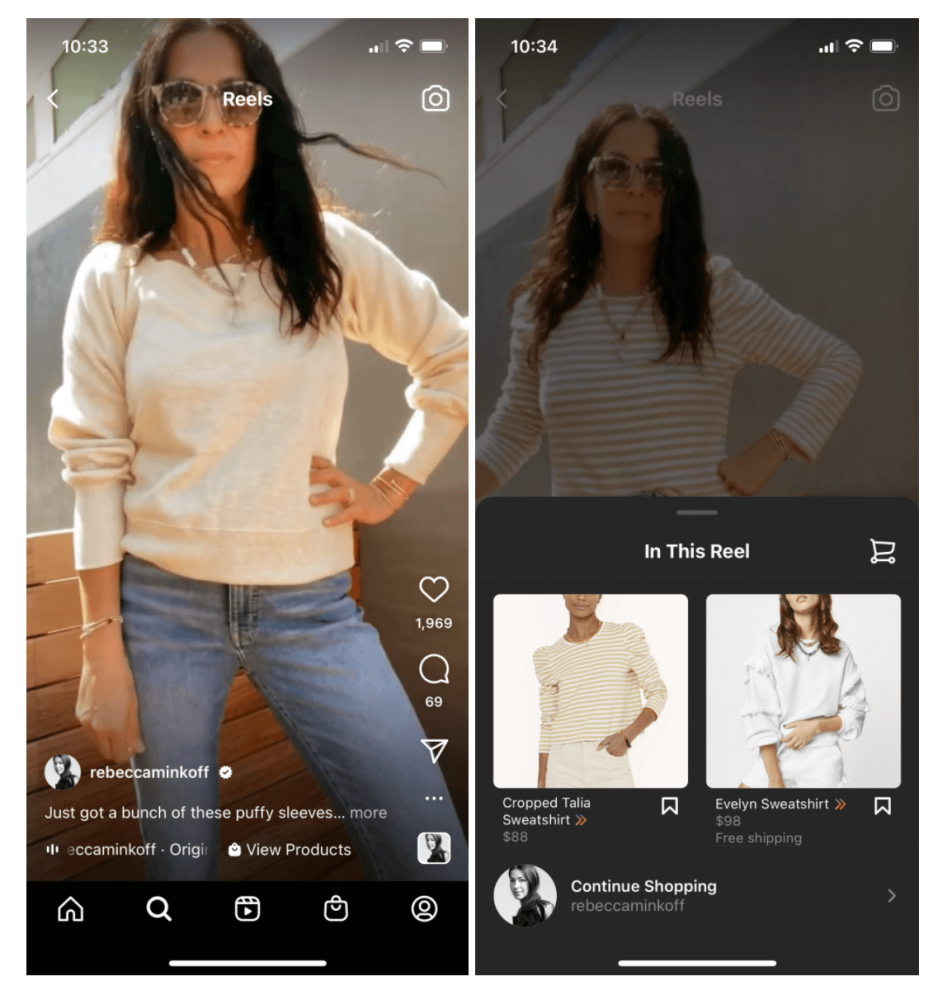 There’s also a clear CTA on most of her Reels. Whenever a product is featured in a video, Rebecca Minkoff tags those products so customers can easily view and purchase them.
There’s also a clear CTA on most of her Reels. Whenever a product is featured in a video, Rebecca Minkoff tags those products so customers can easily view and purchase them.
7. Try out direct mail
Here’s a form of retail advertising you might not have thought about in a while: direct mail. With digital advertising taking over marketing playbooks, many businesses underestimate the power of direct mail.
Direct mail has a higher ROI than many types of traditional and digital advertising, just below social media and email.
How you manage a direct mail campaign is up to you—you could try a national campaign focused more on your ecommerce presence, or hyper-local advertising campaigns for consumers near your physical locations. Your marketing team should have data that will inform which tactic to take. If not, it’s time for a test.
8. Leverage local SEO
Local SEO is crucial for businesses as it helps improve visibility in search engine results for local queries, driving targeted traffic from potential customers in the nearby area. This can dramatically increase your chances of converting local searchers into customers, leading to increased foot traffic and sales.
Optimizing for local SEO also helps to build a stronger local online presence, which can improve your brand’s credibility and customer trust.
Need some help claiming your business on Google Business Profile (formerly Google My Business) and getting found on local searches? Download our step-by-step guide.
8 retail marketing and promotion ideas
How do you make your store an exciting place to be? How do you build brand affinity? Here are some retail marketing ideas you might want to steal.
1. Promote your loyalty program
Loyalty programs are a great promotional idea for retail stores to show their appreciation for loyal customers. Pulling purchase history and customer data from your commerce platform can help you craft more personalized promotions. 72% of customers say they will only engage with personalized messaging.
You can also consider adopting different platforms for your loyalty communications, including email, social media and SMS text messaging. Giving customers choices on how they can be contacted also shows you’re paying attention to their preferences.
Segmenting loyalty program members based on sales history—you can do this automatically with Lightspeed Advanced Marketing—will help you ensure your campaigns are as tailored as possible, keeping customers engaged once they’ve signed up.
2. Start a referral campaign
Capitalize on word-of-mouth marketing with a referral campaign. While there are many variations on referral campaigns, the core idea is that you provide some sort of incentive for your happy customers to share the word about you to their friends.
Stitch Fix, a fashion box company, has referral marketing down to an art. Their referral campaign is such a permanent part of their strategy that it has its own page on their website.
Each customer is provided with a unique link to Stitch Fix’s home page. The customers can then share this link with their friends and social network. When someone purchases a box using that link, the original customer is given a $25 credit towards their next box. (And the new customer is enticed to make a purchase with their own $25 credit.)
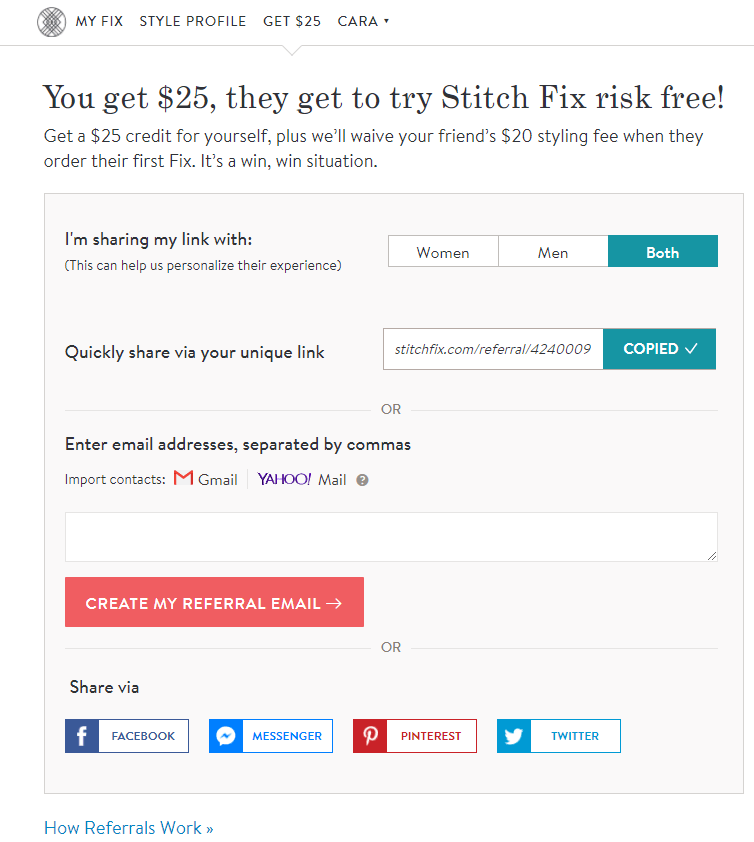
For stores looking to replicate Stitch Fix’s success, consider testing out referral marketing with an initial campaign. Choose your incentive, set up goals and get cracking.
Referral programs are an incredibly effective retail marketing strategy, with 92% of customers trusting recommendations from people they know.
Creating incentives for customers to refer their friends can bring in high-value traffic and encourage repeat purchases from both. A popular way to do this is to offer a coupon for customers and their friends if they successfully refer someone. You can promote your referral and loyalty programs both online and in-store.
3. Run a win-back marketing campaign
Marketing to new shoppers is great, but what about your existing customers? Specifically, those who haven’t shopped with you in a while. Identify inactive shoppers and win them back with a marketing campaign showing them what they’re missing.
A good example of this in action comes from Our Bralette Club (OBC), a lingerie retailer based out of Singapore. OBC uses their marketing platform to automatically run win-back campaigns.
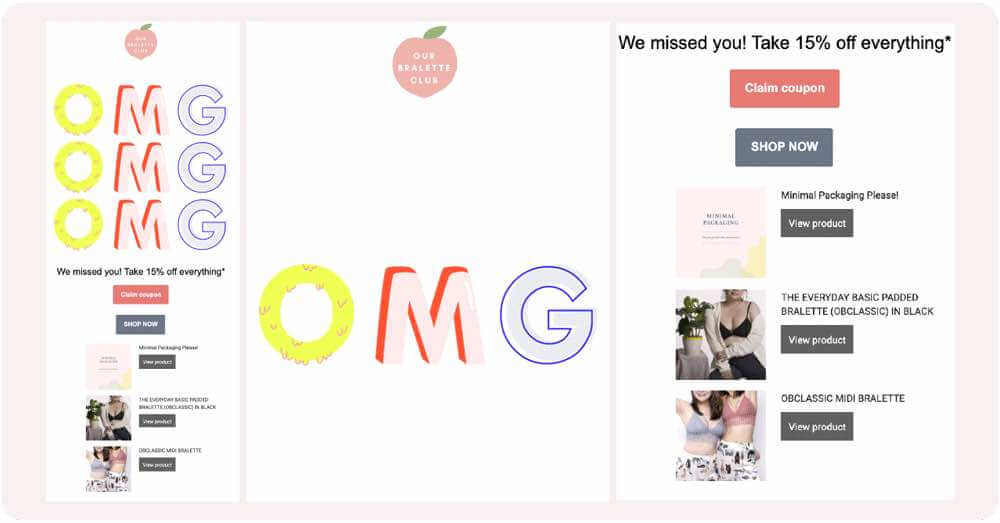
OBC automatically identifies customers who haven’t shopped with the brand in a while, and sends them a series of messages encouraging them to come back—complete with a 15% coupon. These messages have generated amazing results. OBC earned $4,000+ in revenue in just 4 months thanks to this automated email flow.
4. Run in-store events
In-store events can do wonders when it comes to bringing more foot traffic into locations. There are plenty of in-store event ideas that you can take advantage of. A wine store could hold a tasting, a studio gym could have a healthy cooking class and an art store could host a painting class, to name a few examples.
In addition to bringing in traffic resulting in sales, events are also a great way to generate buzz on social media and nurture relationships with attendees.
You can connect your brand to both your community and a cause by hosting a charitable event that includes a donation. This is a powerful way to give back, while also building a positive reputation for your brand. Showing that you care about doing good can impact how customers see you and your business.
5. Offer free wifi
While free wifi is quickly becoming standard, your customers are still likely to see it as a perk, with 50% of customers saying they are more comfortable making large purchases in stores that offer free wifi.
And that’s a pretty good reason to offer free wifi in and of itself. But there’s a second benefit—free wifi is good marketing for retailers, because you can collect contact information to use in future campaigns and promotions.
6. Run seasonal retail marketing initiatives
Ensure that your retail marketing activities keep up with seasonal events. Think Mother’s Day, Father’s Day, back to school, Christmas and more.
For example, for Father’s Day, lululemon ran an email marketing campaign featuring “Dad’s favorite gifts”. The message showcased the brand’s menswear and made it easy for customers to find gift ideas by categorizing gift ideas based on various activities (e.g. casual, workouts, etc.).
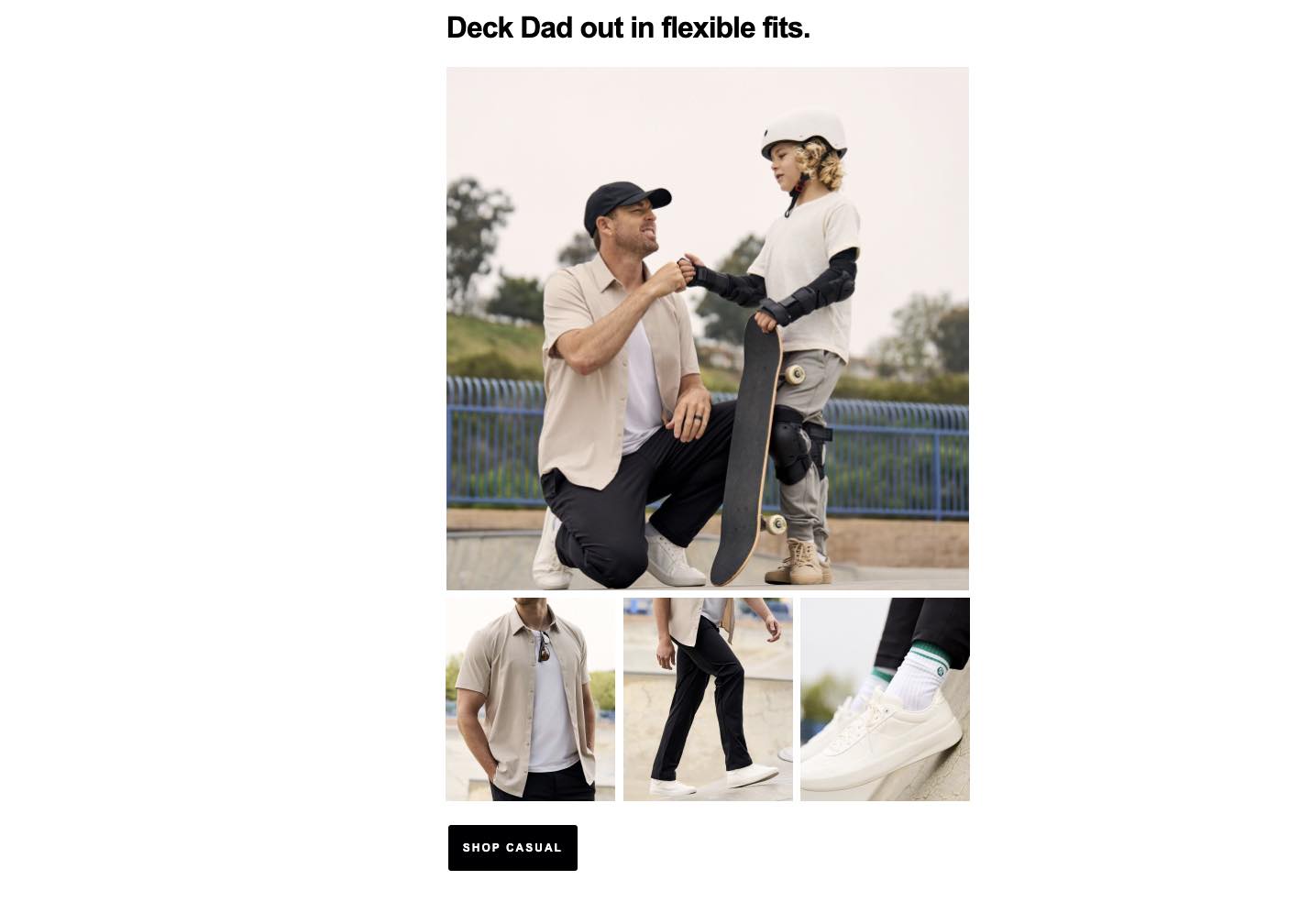
Now, the big holidays are obviously a no-brainer, and you should definitely consider promotions in line with these events. But here’s one of our favorite retail marketing tips: explore and celebrate smaller, more niche holidays that resonate with your customers (or customers-to-be).
Let’s say you sell sporting goods. In this instance, following sporting events or official sports days (like World Pickleball Day) can drive targeted promotions and increase engagement among specific sports communities.
Or, let’s say you’re a gift shop that sells presents for all occasions. Pay attention to lesser-known observances and quirky holidays that resonate with your audience. Sugarwish, for example, recently sent an email celebrating Administrative Professionals’ Day to encourage customers to send gifts to their favorite administrators.
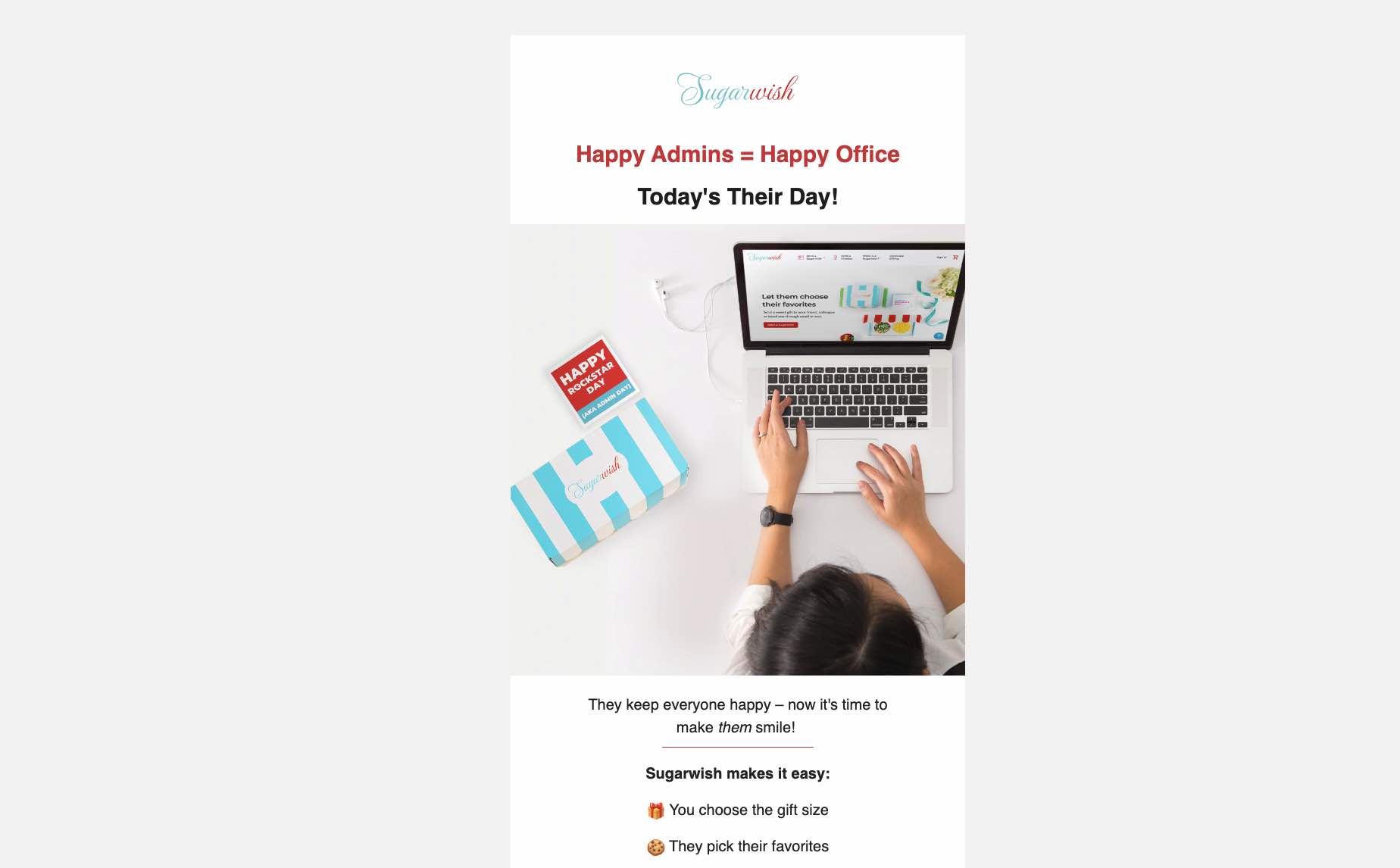
7. Double down on local marketing
Shop Local movements have been growing for quite some time now, which is why it’s a good idea to explore local marketing opportunities. From sponsoring local events to partnering with neighborhood organizations, you can build strong community relationships and boost your brand’s visibility.
Another idea is to stock inventory from local suppliers and highlight these products in your store and marketing materials.
Doing so can attract customers who are passionate about supporting their local economy, differentiate your store from larger chains and foster a sense of community pride and loyalty.
8. Personalize the customer experience
Personalization has become one of the most indispensable marketing strategies for marketers worldwide. Why?
- 80% of consumers are more likely to make a purchase from a brand that provides personalized experiences.
- 88% of U.S. marketers reported seeing measurable improvements due to personalization, with more than half reporting a lift greater than 10%.
- 47% of consumers will check Amazon if the brand they’re shopping with doesn’t provide product suggestions that are relevant.
If you take anything away from these retail marketing tips, let it be that you absolutely must be focused on personalization. Still need convincing? Here are 50 stats showing the power of marketing personalization.
Data analytics will help you better understand your customers’ preferences and personalize their shopping experience. Tailoring recommendations and personalizing your marketing messages can significantly improve customer satisfaction and loyalty.
We know, easier said than done. Thankfully, there are advanced marketing tools that can help you streamline and even automate your personalized marketing campaigns so you can more or less set it and forget it.
How to implement your retail marketing strategy
There’s no shortage of retail marketing tips and tactics out there. So, how can you craft a strategy that works for your business? Take the following steps:
Define your goals
Clearly outline what you want to achieve with your retail marketing strategy. What does it look like? Whether it’s increasing sales, boosting brand awareness or attracting new customers, having specific goals will guide your efforts.
Understand your audience
Conduct market research to gain insights into your target customers’ preferences, behaviors and needs. This will help you tailor your marketing messages and tactics to resonate with them effectively.
Choose the right channels
Identify the most effective marketing channels for reaching your audience. This could include social media, email marketing, local events or in-store promotions, depending on where your customers are most active.
Optimize the mobile experience
Make sure your website and online store are mobile-friendly—seriously. Mobile retail ecommerce sales in the US exceeded $491 billion USD in 2023, accounting for over 15.6% of total retail sales. That figure is expected to double by 2027.
With increasing mobile usage, a seamless mobile shopping experience will become table stakes for retailers and a key part of any customer retention strategy.
Create compelling content
Develop engaging and relevant content that captures your audience’s attention. Great content can come in the form of:
- advertisements
- PR pieces
- blog posts
- social media content
- videos
- email newsletters
Put stuff out there and see what resonates. This is the best way to find the mix that works for you and your audience.
Leverage data and analytics
Use data and analytics to track the performance of your marketing efforts. This will help you understand what’s working and what’s not, allowing you to make informed adjustments to optimize your strategy.
A retail point of sale with robust reporting features will make understanding your data a lot easier so you can put it to good use. For example, every Lightspeed Retail plan includes instant access to your most important sales metrics—sale values, gross profit, revenue, etc.—for your day, week and month. Learn more about basic reporting.
With advanced reporting, you get access to even more sales reports, a sales summary that allows you to track sales progress, forecast for future periods and make promo decisions based on real time data, and additional metrics such as:
- COGS
- Return count
- Return (%)
- Customer count
- Average items per sale
- Average sale value
- And way more
With Lightspeed’s advanced reporting, you can also customize your home dashboard. Learn more here.
Monitor and adjust
Continuously monitor the results of your marketing activities and be prepared to adjust your strategy as needed. Staying agile and responsive to market trends and customer feedback will ensure long-term success.
Find the right marketing mix for your retail store
Starting out with the right retail strategies for your campaigns can make a huge difference. When you choose a retail marketing strategy that makes sense for your brand, you’ll be able to invest your budget wisely into in-store and online promotions that work well for you.
Remember that all businesses can benefit from a strong marketing mix. Having different touch points allows you to be more discoverable and accessible to your customers. Want more retail marketing tips? Download our free guide.
Need stronger tools to manage your marketing efforts? Watch a demo to see how Lightspeed can help you make smarter business decisions.
FAQs
What are the 4 principles of retail marketing?
The four principles of retail marketing are:
- Product: Offering the right product that meets the needs and preferences of the target market.
- Price: Setting a competitive price that reflects the value of the product and aligns with the target market’s expectations.
- Place: Choosing the right locations for selling the product, including physical stores and online platforms.
- Promotion: Using various promotional tactics to create awareness and interest in the product, including advertising, sales promotions, public relations and social media.
What is a retail selling strategy?
A retail selling strategy is a plan that outlines how a retailer will attract and sell products to customers. This can include in-store merchandising techniques, personalized customer service, loyalty programs, special promotions, and utilizing data and analytics to understand customer preferences and optimize sales.
What are examples of retail advertisements?
Examples of retail advertisements include:
- Social media ads promoting a store’s latest sale
- Email newsletters announcing new product arrivals
- In-store displays and signage highlighting special offers
- Print ads in local newspapers or magazines
- Television commercials showcasing seasonal promotions
- Online banner ads targeting specific customer demographics

News you care about. Tips you can use.
Everything your business needs to grow, delivered straight to your inbox.



![11 Tips To Make Your Pop-Up Shop a Roaring Success [For Retail Store Beginners and Pros Alike]](https://blog-assets.lightspeedhq.com/img/2021/06/2da3ae10-blog-hero_pop-up-shop.jpg)